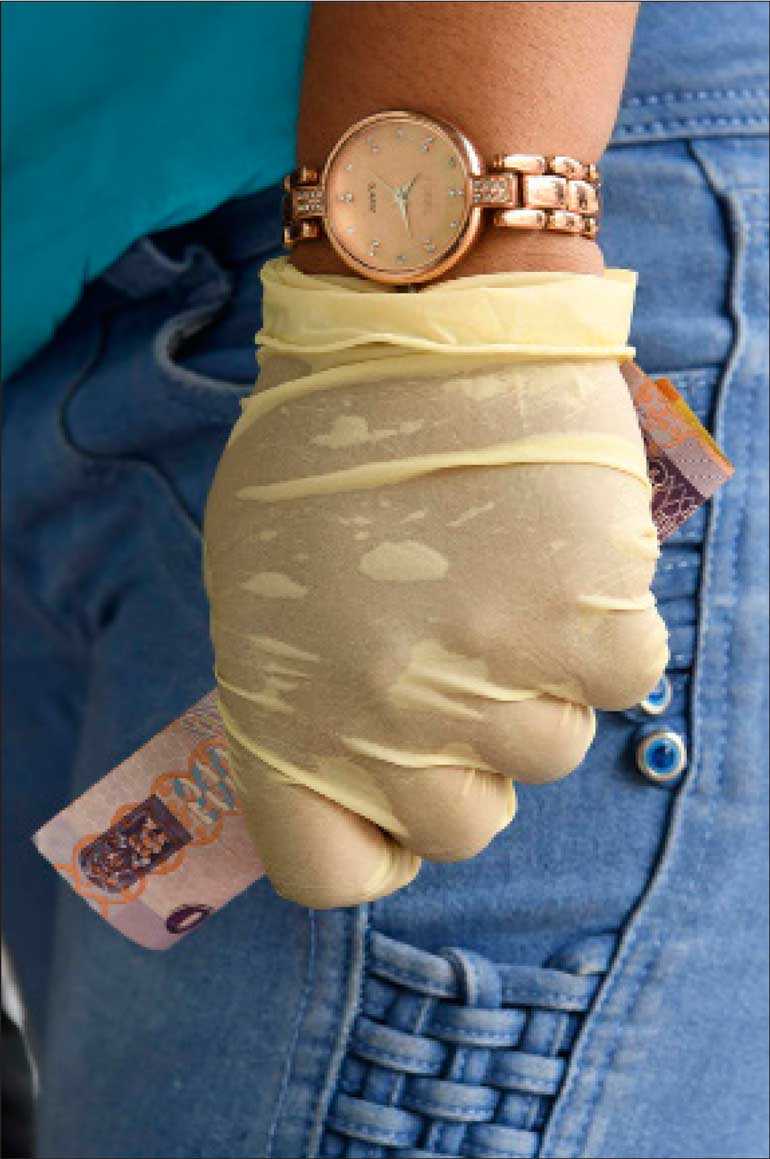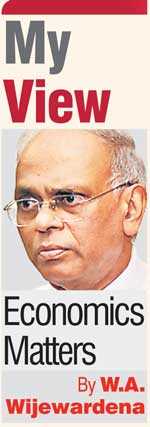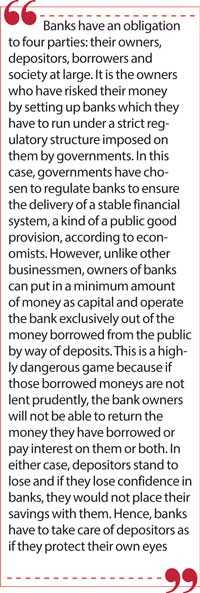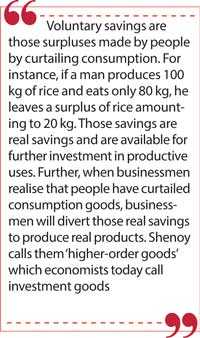Thursday Apr 25, 2024
Thursday Apr 25, 2024
Thursday, 16 April 2020 00:20 - - {{hitsCtrl.values.hits}}

Attack on banks
A section of politicians and civil society leaders has been critical of banks for not being of help, maybe sufficiently, to people for resuscitating the economy now virtually dead. It became dead following the  disruption to economic activities emanating from the anti-COVID-19 measures adopted in the country since mid-March.
disruption to economic activities emanating from the anti-COVID-19 measures adopted in the country since mid-March.
Banks for them mainly mean commercial banks, but a proper definition should include all financial institutions. The argument has been that banks have made super profits by lending to customers and now, when their customers are in trouble, banks have neglected their needs. The demand has been to make a redistribution of the gains made in the past in what normally happens in a socialist economy: you get from society and then in turn give it back to society.
The danger of the epistemocrats capturing power in society
When political leaders claim to possess this knowledge not known to others and they are assertive enough to gather followers around them, this demand becomes a social movement to be reckoned with. Such a system infested by social movements orchestrated by one section against another is far from the ideals of democracy. It has been aptly branded as ‘epistemocracy’ by Nassim Taleb in his 2007 book The Black Swan.
The danger of the proliferation of such epistemocrats in society is that they use their assertive power to gain authoritarian powers for themselves. Surely, that will be fatal not only to financial institutions but also all others.
Banks making super profits
Of course, there is an element of truth in the assertion that banks have been making super profits. Even in a background of the disruption of economic activities for eight months after Easter bombings of April 2019, the year has been extremely profitable to financial industry. In all, they have made an after-tax profit of close to Rs. 150 billion in 2019. This has to be viewed in the light of the shrinking of the real economy in US dollar terms from $ 88 billion in 2018 to $ 84 billion in 2019.
Financial institutions should, therefore, take pride in being able to outperform the real economy, but it has become the bone of contention by others. However, one should recognise that these profits have been made on a thumping asset base of about Rs. 15 trillion which is as high as a fifth of the size of the real economy. Hence, in terms of the asset base, it is only a return of 1% on assets employed and, therefore, not an enviable achievement that could be termed abnormally high. It is usually the norm throughout the financial industry globally.
Banks branded as Shylocks
However, historically, bankers, as money lenders, have been at the receiving end of society. They have been derogatively called Shylocks who demand ‘the pound of flesh’ unreasonably from their customers, a phrase that has come to be used due to a reference in Shakespeare’s ‘The Merchant of Venice’. Ancient European communities had disliked Jews for being too greedy when engaging in money lending business.
But the perception about money lending has been different among commercial communities in the Middle East and in India. Prophet Muhammad, while frowning on anyone at not repaying debt had also banned charging of interest on loans claiming that one is entitled only to the capital lent. However, the person who makes available funds is entitled to a part of profits if the user makes profits. This guide has been the principal ideal in Islamic lending. It has served as a moral guide for both the borrower and the lender by converting them to a team of entrepreneurs who should be ready to bear both losses and profits.
The Buddha: What is borrowed should be repaid
The Buddha had emphasised on the wholesomeness of leading a debt-free life in Anana Sutta or Discourse on Debtlessness in Anguttara Nikaya (available at: https://www.accesstoinsight.org/tipitaka /an/an04/an04.062.than.html).
/an/an04/an04.062.than.html).
He had also upheld in Samagnaphala Sutta or Discourse on Fruit of Contemplative Life in Diga Nikaya (available at: https://www.accesstoinsight.org/tipitaka/dn/dn.02.0.than.html) that money borrowed should be spent prudently in further wealth building and should be repaid in full with interest to the lender.
He should use for his own family only what is remaining after fully repaying the debt. Thus, according to the Buddha, it is the responsibility of the borrower to use prudently what he has borrowed and settle his debt in full.
Kautilya: Compensate the lenders with interest
Kautilya, the 3rd century BCE Indian Economics Guru credited for the treatise on economics, The Arthashastra, had provided detailed rules and guidelines for lending and loan recovery to facilitate the smooth operation of the commerce-based ancient Indian economy. While lending agreements should be open, transparent and unambiguous, a lender should not increase interest, among others, if the debtor is ill or insolvent.
At the same time, those who have accepted deposits should compensate the depositor appropriately with interest. According to Kautilya, once agreed, interest should not be changed during the currency of a loan and no interest should be charged on interest on arrears. In all other situations, the borrowers have obligation to repay the loans together with interest and lenders have a right to recover those loans through the available legal channels.
Banks’ obligations are wider
In my view, banks have an obligation to four parties: their owners, depositors, borrowers and society at large. It is the owners who have risked their money by setting up banks which they have to run under a strict regulatory structure imposed on them by governments. In this case, governments have chosen to regulate banks to ensure the delivery of a stable financial system, a kind of a public good provision, according to economists.
However, unlike other businessmen, owners of banks can put in a minimum amount of money as capital and operate the bank exclusively out of the money borrowed from the public by way of deposits. This is a highly dangerous game because if those borrowed moneys are not lent prudently, the bank owners will not be able to return the money they have borrowed or pay interest on them or both. In either case, depositors stand to lose and if they lose confidence in banks, they would not place their savings with them. Hence, banks have to take care of depositors as if they protect their own eyes.
Lend further money to keep an ill-fated borrower alive
At the same time, banks have an obligation to their borrowers because it is those borrowers who keep a bank above the waters by paying interest on the money they have borrowed. In this case, a bank has to resolve a dilemma as cogently put by Leonard Woolf in his fiction depicting the plight of the residents in a southern village during colonial times, The Village in the Jungle. There is a Muslim trader who comes to this village from Batticaloa on foot. He advances money to villagers so that they could eat enough and cultivate various grains which they could give back to the Muslim trader in settlement of the money they have got.
However, when the trader comes back, he finds that many villagers have not been able to produce any grain because they had been down with malarial fever for most of the time. But these grains are so valuable to the trader that he has to give more money to villagers as advances because to recover the original moneys, they have to survive and produce those grains. Hence, it is a repeat exercise year after year.
This dilemma of the Muslim trader is in line with the guidelines of Kautilya that a creditor should not insist on repayment of money he has lent if the borrower is ill or insolvent.
Politicians should not play reverse Shylock strategy on banks
Banks have a responsibility to society at large because they are social institutions that provide a host of services: functioning as a depository of savings, meeting the fund requirements of needy individuals, keeping the economy going and helping people to become prosperous. These obligations to society are beyond their profit goals. Hence, a bank has to very carefully balance the obligations to owners, depositors, borrowers and society at large. Hence, any relief given to borrowers should not conflict their other obligations.
The economic catastrophe that has been created by the unexpected COVID-19 pandemic has placed banks in this crucial choice-making position. A bank cannot abandon its borrowers and at the same time disregard its obligation to depositors. If one is done to the exclusion of the other, the bank loses and so does the society. Hence, politicians should be careful in not playing the reverse of the Shylock principle: demanding the pound of flesh from banks.
Central Bank’s timely action to provide liquid cash
Surely, the banks have a responsibility for supporting their borrowers. The Central Bank, having recognised this need, has created a special fund of Rs. 50 billion to provide refinance to lending institutions which will provide relief to borrowers in the form of providing a debt moratorium and lending the needed funds to overcome the present impasse at a highly concessionary rate of 4%.
Banks which can borrow funds at 1% from the Central Bank have to repay the same within 20 months. This is, in my view, a sufficient period for any businessman to put his business back to operational form. This is the most immediate requirement and the Central Bank has correctly addressed the issue.
Voluntary savings by curtailing consumption are real savings
However, the medium to long-term reconstruction of the economy cannot be done solely by using bank lending. In this connection, the distinction made by the Indian economist, B.R. Shenoy, who was a lecturer in economics at the University of Ceylon in early 1940s, between voluntary savings and involuntary savings, outlined in a book published in 2004 under the title Theoretical Vision, would help us to understand the issue.
Voluntary savings are those surpluses made by people by curtailing consumption. For instance, if a man produces 100 kg of rice and eats only 80 kg, he leaves a surplus of rice amounting to 20 kg. Those savings are real savings and are available for further investment in productive uses. Further, when businessmen realise that people have curtailed consumption goods, businessmen will divert those real savings to produce real products. Shenoy calls them ‘higher-order goods’ which economists today call investment goods. It changes the structure in the economy by moving from production of bullock carts, for example, to trucks, from bullock driven ploughs to tractors, etc.
The proliferation of these higher-order products will help an economy to produce more consumption goods of high quality later. What is needed for long term economic prosperity is the boosting of these voluntary savings which are also real savings. A must for the generation of these real savings is the generation of a surplus in the current account of the balance of payments.
B.R. Shenoy: Involuntary bank made savings are a disaster
Involuntary savings are those savings which are generated by artificial credit expansion by banks with support from the country’s central bank. These savings are imaginary savings arising from the imaginary assets of the financial institutions as against the real savings made by people by curtailing their real consumption.
For instance, consider this case: the central bank prints one rupee and makes it available to government to finance its budget. In economist’s terminology, this is called creating reserve money or monetary base just like a magician waves a magic wand to make a rabbit appear out of nowhere. Nobel Laureate Milton Friedman chose to call such money ‘helicopter-dropped money’ because they are just printed by a central bank and dropped on people from the sky.
A part of this money goes back to the banking system enabling it to create multiple deposits and credit simply by making book entries. Those book entries create assets for people as well as for banks, but they are simply imaginary assets without any real baking like the 20 kg of rice saved by a person in our previous example. The danger of such imaginary assets is that they appear to be solid right now but can meltdown if the economic system is hit by a crisis like a global financial crisis or a pandemic as the world has faced today.
To rescue banks, real resources have to be transferred to banks from taxpayers to the banking system. In Sri Lanka, within a time lag of some 18 months, banks can create seven rupees out of a rupee imaginarily created by the Central Bank. These savings, according to Shenoy, do not help a country to put its economy on a solid long-term growth path.
He emphasised that they must necessarily lead to disaster, though at first, they may produce outward symptoms like the country heading toward an economic boom. Hence, Shenoy dismissed such attempts of using involuntary savings claiming that they are not a substitute to voluntary savings which are real in nature.
Sri Lanka should go for real sacrifices
Voluntary savings are a sacrifice made by people and Sri Lanka’s long-run reconstruction depends on making such sacrifices across the board. That has to be made by all, from the President downward to the lowest stratum in society, voluntarily. Some private companies have already started the initiative by enforcing a pay-cut at high rates at high levels and low rate at low levels. It is similar to paying back to the company what the employees have got.
For instance, a 50% pay cut means that the person concerned has agreed to work six months free of salary for the company to enable it to wade through the difficult period. Similarly, if ministers voluntarily go for a 50% cut in their perks, they would be providing their services free of payment for six months to the nation. This is similar to the old Rajakaari Kramaya or Compulsory Service to the King that was there during the times of ancient Sinhala kings. The beauty of this move is that it will set the appropriate example for others to follow.
Hence, banks can help the economy to pass the current impasse but they cannot bear the burden of long-run reconstruction by producing imaginary paper assets.
(The writer, a former Deputy Governor of the Central Bank of Sri Lanka, can be reached at [email protected])